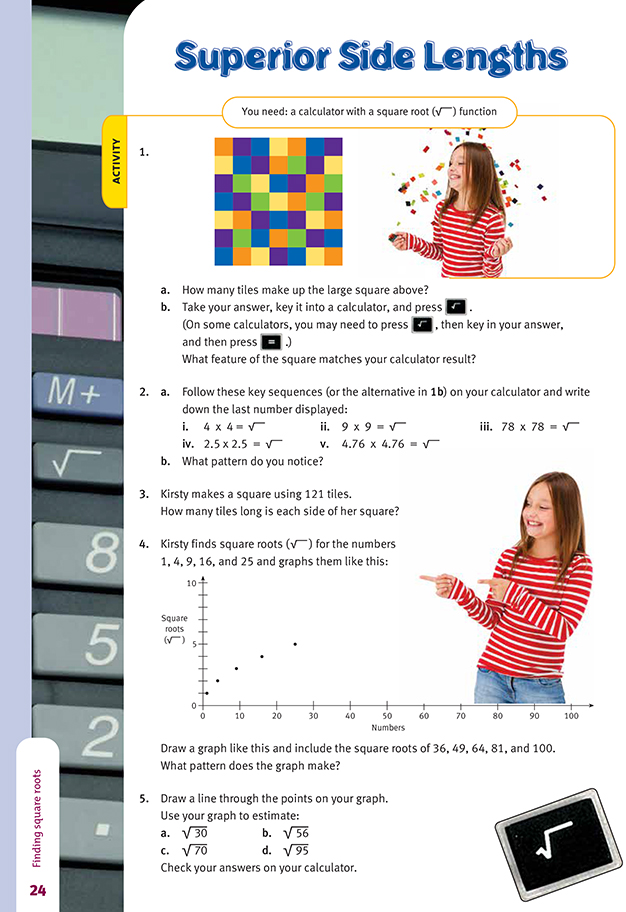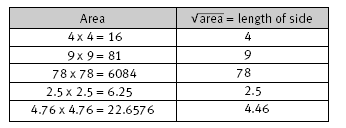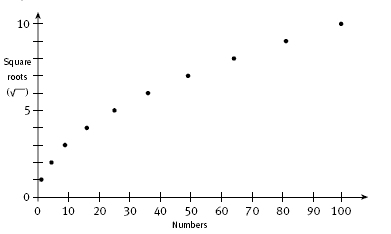This is a level 5 number link activity from the Figure It Out series. It relates to Stage 8 of the Number Framework.
A PDF of the student activity is included.
Click on the image to enlarge it. Click again to close. Download PDF (196 KB)
find square roots of numbers
A calculator with a square root (√) function
FIO, Link, Number, Book Four, Superior Side Lengths, page 24
Question 1 introduces students to a visual notion of the square root as the length of one side of a square shape as well as to the procedure for finding the square root on a calculator. After the students have answered question 1a, ask them for a number that when multiplied by itself gives √49. Explain that the square root of 49 is 7 or that 49 represents a number that, when multiplied by itself, is equal to 49. Discuss other
examples using perfect squares, such as 9, 25, 64, 100, and so on.
Question 2 continues to explore the square root (length of the side of a square) using the calculator and the square root key. This time, the students will discover that, for many squares, the square root is not necessarily a whole number. Make sure that the students follow the correct procedure for their type of calculator.
The students can draw up a table to record the measurement of the squares:
Question 3 involves a larger square with a whole-number side. It can be drawn on grid paper with the tiles on one side shaded and counted. However, when your students are working on this, encourage them to first guess and then check their guesses, with successive approximations being made to find the square root.
For example: “I know 10 x 10 = 100, which is too low. I’ll try 11 x 11 next”, and so on. Using the calculator to check mental approximations will help the students to gain a better understanding of the concept of square roots. You could use some other three-digit perfect-square numbers to extend and consolidate this experience,
such as 196, 529, 9, and so on.
The students should draw the graph for question 4 on grid paper, taking care to plot the points accurately to help achieve a good result at question 5. After discussing the graph pattern, continue to encourage prior thinking and estimation before the students find an approximate answer from the graph and an exact answer, as a check, on the calculator.
Discuss what the students think is the square root of 46. Then encourage them to narrow down the possibilities by guessing and checking. You could ask:
“What two square numbers is this number between?” (36 and 49)
“What two numbers will the square root be between?” (6 and 7)
“Is it a whole number?” (No)
“Will it be above or below 6.5?” (Above)
“What number could you press into your calculator for the sides? Is it above 6.6?” (Yes)
The students may be able to suggest where the side lengths (square root) will fit on a number line before they check the graph.
You may like to use an enlarged number line for follow-up discussion for all the question 5 examples and also a graph outline for shared recording and checking of students’ own results on the overhead projector. The students can verify their answers by using the √ key on the calculator.
The students should read the line graph first from the horizontal axis and then from the vertical axis. A ruler can help link the number from the graphed line to the axis. The value that the students interpolate is an estimate that need not go beyond one decimal place.
This overall progression from perfect-square, whole-number shapes to imaging, number lines, and graphs, all supported by mental estimation, will provide a solid basis for students to progress to using calculators for symbolic calculations.
Answers to Activity
1. a. 49. (7 x 7)
b. √49 = 7. This gives the side length of the square.
2. a. i. 4 ii. 9 iii. 78 iv. 2.5 v. 4.76
b. Answers will vary. You always end up with the number you started with because the square root undoes the squaring. A general rule for this is √(n x n) = n.
3. 11 tiles long
4.
The pattern is a curved line continuing upwards.
5. Estimates will vary. The answers, rounded to 1 d.p., are:
a. 5.5
b. 7.5
c. 8.4
d. 9.7



